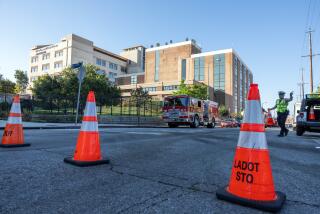Emotional Rescue : Quake: Stymied by Japanese reluctance to let foreigners treat patients, Southland medical team provides a grief therapy session--and kitchen help--instead.
- Share via
KOBE, Japan — Frustrated members of a Southern California medical relief team finally got a chance to help on Tuesday, but in a much different way than expected.
*
After hiking seven miles through some of the most ferociously flattened neighborhoods in this otherwise gorgeous seaside city, nine doctors and nurses from the 18-person squad peeled vegetables, straightened X-ray filing cabinets, sterilized surgical equipment and conducted a grief therapy session at a Koreatown hospital where medical personnel welcomed them with hugs, tears and praise.
“They rescued us,” said Dr. Jung Hyo Kim, emergency room chief at Kobe Asahi Hospital, of the surprise assistance. “Our trauma team needed critical care, and the American doctors somehow appeared when we needed them most.”
On Monday, some of the U.S. visitors had been so frustrated in their attempt to heal the wounded of Kobe’s massive earthquake that they had threatened to leave. But Tuesday afternoon the group was able to make a dent. Their moment came during a bereavement therapy session attended by about 20 Kobe Asahi doctors and nurses.
Ed Lowder, a Northridge emergency room physician, started the workshop by describing his experiences during last year’s Northridge earthquake. Then he invited the Japanese doctors and nurses to explain to each other, for the first time, how the Kobe quake had affected them.
Stoic men and women crumbled into tears as they described working for seven days straight after losing mothers and siblings in the catastrophe. They expressed shame over quarrels they had had as stress built at home and on the job. One harrowing story built on another. Soon the whole room was bawling.
One local doctor spoke of the guilt he felt at working 16-hour days at the hospital and ignoring his family and non-critical patients. Kim admitted he had erred by once describing to a colleague how nice it was to commute home to Osaka and have a warm bath, without realizing how that hurt staff members whose homes had collapsed.
The Americans had been organized less than a week ago in the belief that Japan needed trauma-care specialists to assist in the treatment of the Kobe earthquake’s 50,000 wounded. Upon arrival in the city, however, the gung-ho emergency room doctors and nurses discovered that their Japanese counterparts had a much more narrow view of volunteerism. It is a foreign concept in this stubbornly self-reliant society: Hospitals in one section of town don’t even like to accept help from physicians in other sections, much less from other regions of the country or the world.
The first day the Americans reported for duty, Kobe municipal health officials shuttled them from meeting to meeting at department headquarters before letting them visit (but not treat) what one nurse derisively called “cough-and-cold patients” at one refugee center clinic for a couple of hours.
Stung by news reports of the doctors’ unease, the city on Tuesday dispatched half of them to Kobe Asahi Hospital, an institution in a low-income neighborhood that residents say is typically ignored by officials.
Their arrival was a bit clumsy, as Japanese health executives tried to figure out how to accommodate colleagues whom they considered guests more than assistants. But during a tour of the building, Jim Davis, a Universal Studios first-aid nurse, spied the kitchen--and asked to help prepare meals. He was quickly put to work measuring rice and cutting radishes.
Northridge Hospital Medical Center critical-care nurse Charles Fife volunteered to help in central supply. Northridge’s Lowder picked up X-rays that had spilled out of a cabinet and had been on the floor for days. He also flattened cardboard boxes for garbage pickup. Northridge anesthesiology chief Steve Cantamout helped to clean the operating room.
During the bereavement session, Tharp also advised the Kobe Asahi staff that they would feel better if they smiled more.
“This is very good advice--very timely,” emergency room chief Kim told his staff. “You do not smile because you do not think you have the luxury to smile. But the act of smiling can change your emotions. It is important that we be cheerful and set an example for our community.”
By the end of the day, the Americans had more concretely promised to lobby the U.S. Consulate to urge the U.S. Army to send a water truck to fill the tank at Kobe Asahi. Lacking water, the hospital has put off 135 surgeries over the past week.
However, Kim drew the line of his welcome at the notion of asking the Americans to help with rounds or in the operating room, saying the differences between the two countries’ practices were too great.
Instead, the two sets of physicians agreed to meet today to discuss handing off the job of scrubbing the operating room. Then the Americans departed on a seven-mile hike in the dark back to their home base on a Japanese coast guard cutter.
Said Lowder of the past two days: “It was like climbing Mt. Fuji. We were going to get our chance to help, but we had to work for it.”
More to Read
Sign up for Essential California
The most important California stories and recommendations in your inbox every morning.
You may occasionally receive promotional content from the Los Angeles Times.













